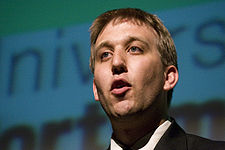- Chris Lintott
-
Chris Lintott 
Born 1980
TorbayCitizenship British Known for Astronomy
Galaxy Zoo
Television presentationChristopher John Lintott (born 1980, Torbay) is an English astrophysicist currently serving as the Director of Citizen Science at the Adler Planetarium.[1] He is a post-doctoral researcher who is involved in a number of popular science projects aimed at bringing astronomical science to a wider audience. He is the co-presenter of Patrick Moore's BBC series The Sky at Night and a co-author of the book Bang! – The Complete History of the Universe with Patrick Moore and Queen guitarist Brian May.[2]
Contents
Academic background
He attended Torquay Boys' Grammar School in Devon, whilst living in Churston Ferrers. Whilst at school, in 1999, he won a $500 Earth and Space Sciences award and the Priscilla and Bart Bok Honorable Mention Award at the Intel International Science and Engineering Fair for an article on Dust Around Young Stellar Objects. This came from a six week project at the University of Hertfordshire funded by a Nuffield bursary. Lintott read for a degree in Natural Sciences from the University of Cambridge where he was a student of Magdalene College. He received a PhD in astrophysics from University College London, where his thesis was on the subject of star formation. He is a fellow of the Royal Astronomical Society and is presently a researcher in the Department of Physics at the University of Oxford and a junior research fellow at Somerville College.[3] His research there focuses on galaxies, galaxy evolution, and on the application of astrochemical models of star formation to galaxies beyond the Milky Way; particularly the use of sulphur compounds as a signature of stars that are in the process of forming.
Popular science
The Sky at Night
He first appeared on the BBC astronomy programme The Sky at Night, presented by Patrick Moore, as a guest in 2000. As Moore's mobility has deteriorated, Lintott has had an increasingly prominent role, often providing on-location reporting from events covered by the programme. He now jointly presents the programme with Moore.
In July 2004 Moore suffered a near-fatal bout of food poisoning and Lintott took over as presenter of that month's episode.[4] It is the only episode which Moore has not presented since the show was first broadcast on 24 April 1957.[5]
Bang! - The Complete History of the Universe
Lintott is the author, along with Patrick Moore and Queen guitarist and astronomer Brian May, of the book Bang! - The Complete History of the Universe, which was produced by Canopus Books and published by Carlton Books on 23 October 2006, has been translated into 13 languages, and recently appeared in paperback. As suggested by the title, the illustrated book is a history of the Universe from the Big Bang to its eventual predicted end. It is aimed at a popular science audience and claims to make its subject matter easily comprehensible to readers who come to it without any knowledge of astronomy.[6]
Galaxy Zoo
 Lintott after a lecture for the Perimeter Institute for Theoretical Physics in April 2010
Lintott after a lecture for the Perimeter Institute for Theoretical Physics in April 2010
Lintott has been involved in an online crowdsourcing project where members of the public can volunteer their time to assist in classifying over a million galaxies.[7] The project, named Galaxy Zoo, is inspired by Stardust@home, where the public were asked by NASA to search images obtained from a mission to a comet for interstellar dust impacts. Describing the Galaxy Zoo project, Lintott commented that, "One advantage is that you get to see parts of space that have never been seen before. These images were taken by a robotic telescope and processed automatically, so the odds are that when you log on, that first galaxy you see will be one that no human has seen before."[7] Volunteers are asked to judge from the images whether the galaxies are elliptical or spiral and, if spiral, in which direction they are rotating.
Publications
- Also see Galaxy Zoo Published Papers
- Lintott, Chris J and Viti, Serena, "Molecular signature of star formation at high redshifts" Astrophysics and Space Science, Volume 313, Issue 1-3, pp. 327–330
- Lintott, CJ; Ferreras, I; Lahav, O, "Massive Elliptical Galaxies: From Cores to Halos" The Astrophysical Journal, Volume 648, Issue 2, pp. 826–834.
- Lintott, Chris and Viti, Serena "Rapid Star Formation in the Presence of Active Galactic Nuclei" The Astrophysical Journal, volume 646, Issue 1, pages L37–L39
- Lintott, CJ; Rawlings, JMC, "Determining the cosmic ray ionization rate in dynamically evolving clouds" Astronomy and Astrophysics, Volume 448, Issue 2, March III 2006, pp. 425–432
- Lintott, CJ; Viti, S; Williams, DA; Rawlings, JMC; Ferreras, I, "Hot cores: probes of high-redshift galaxies?" Monthly Notices of the Royal Astronomical Society, Volume 360, Issue 4, pp. 1527–1531.
- Lintott, CJ, "The age of precision cosmology?" Journal of the British Astronomical Association, vol.113, no.4, p. 231-232
References
- ^ http://www.adlerplanetarium.org/researchcollections/research/researchers
- ^ Brockes, Emma (October 19, 2006). "Friend to the stars". London: Guardian Unlimited Arts. http://arts.guardian.co.uk/features/story/0,,1925602,00.html. Retrieved 2006-11-27.
- ^ "Dr Chris Lintott". Somerville College - University of Oxford. http://www.some.ox.ac.uk/admissions/fellows/lintottc/. Retrieved 2007-10-02.
- ^ "A Brief Interview With Sir Patrick Moore". Universe Today. 15 November 2004. http://www.universetoday.com/am/publish/interview_sir_patrick_moore.html. Retrieved 2007-02-22.
- ^ "Sir Patrick hit by food poisoning". BBC News. 6 July 2004. http://news.bbc.co.uk/1/hi/entertainment/tv_and_radio/3869339.stm. Retrieved 2007-02-22.
- ^ Kennedy, Maev (24 October 2006). "Guitarist joins astronomers to tell history of universe". London: Guardian Unlimited. http://www.guardian.co.uk/space/article/0,,1929767,00.html. Retrieved 2007-01-07.
- ^ a b "Scientists seek galaxy hunt help". BBC News. July 11, 2007. http://news.bbc.co.uk/1/hi/sci/tech/6289474.stm. Retrieved 2007-07-12.
External links
- Chris Lintott's Blog
- Astronomy podcasts by Chris Lintott and Harriet Scott
- Watch "The Sky at Night" free at the official BBC site
News items
Categories:- 1980 births
- Living people
- People from Torquay
- English astronomers
- Alumni of Magdalene College, Cambridge
- Alumni of the University of London
- People educated at Torquay Boys' Grammar School
Wikimedia Foundation. 2010.
